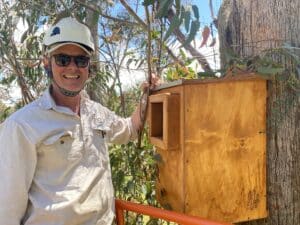One of the most important global meetings on wildlife trade has just wrapped up in Uzbekistan. It’s capital city Samarkand was where governments convened for the 20th Conference of the Parties (CoP20) to the Convention on International Trade in Endangered Species of Wild Fauna and Flora (CITES) to decide how international trade should be managed for some of the world’s most threatened...
Five years after the devastating 2019 Black Summer bushfires, Steve Haslam, owner of Tenterfield’s Quoll Headquarters, is now seeing the return of native species to his acclaimed wildlife sanctuary.
The fires’ widespread destruction of large tree hollows—a crucial animal habitat used for refuge, safety, roosting and breeding—would prevent wildlife from returning. Haslam’s solution was to use 300 nesting boxes (artificial hollows) to give the wildlife a head start.
“Brushtail possums and sugar gliders have been the main beneficiaries of the boxes with a healthy take up and subsequent population recovery,” Haslam said.
“And we have seen the return of ringtail possums through a reintroduction program. The recovery of these three species is vital to the return of our large owls to the sanctuary and we have recently spotted masked owls again and hope to see powerful and sooty owls again soon.”
The fires also decimated populations of rosellas, lorikeets and kingfishers. Today, birds including king parrots, and crimson and eastern rosellas, have taken up residence in the artificial hollows; and sightings of yellow-tailed black cockatoos are becoming common as banksias recover.
“I’m hopeful that as these populations flourish, they will increase biodiversity, and we’ll see the return of other rare and threatened species like the greater and yellow-bellied glider, the glossy black cockatoo, and the powerful, sooty, and masked owl—we haven’t seen those since the fires,” Haslam said.

Above: Steve Haslam from Quoll Headquarters in Tenterfield with one of the nesting boxes
he’s using to attract native species back to his wildlife sanctuary. (Photo supplied)
Haslam is a member of Humane Society International (HSI) Australia’s Wildlife Land Trust (WLT) national private land conservation program.
HSI Australia facilitated a grant which allowed for the 300 nest boxes and a hydraulic boom-lift (cherry picker) to install, monitor, and maintain them.
Approximately 80 per cent of the nest boxes have now been installed, with each one numbered to aid with research.
“We’re collecting a rich data set on each nest box so we can monitor individual species’ recovery and work out the exact preferences for each species that use the boxes. That data can then be rolled out on any future fire ground in Australia where the same species are impacted, giving them the best possible chance of recovery,” Haslam said.
Evan Quartermain is HSI Australia’s Head of Programs and manager of the Wildlife Land Trust initiative.
“Steve and Quoll HQ really epitomise what the WLT is all about,” Quartermain said.
“We’ve seen his commitment to helping threatened species like the spotted-tailed quoll on his property over many years now. For Steve to identify a critical need and take the initiative to find a solution, is doing wonders for the recovery of local species.
“And the data Steve is collecting will no doubt help countless animal populations around Australia in the future.”
Despite the success, Steve Haslam remains realistic about the threatened native animal populations around Tenterfield.
“It’s wonderful to see the recovery of some of our more iconic species but it has only been five years since the fires, so the sanctuary and surrounding National Parks still have a long, slow road to recovery ahead,” Haslam said.
“The nest boxes are now an integral part of the habitat at Quoll Headquarters, and we will continue to monitor the boxes as part of our ongoing operations.
“We can’t wait to see just how many species take up residence.”
This story first appeared in the Tenterfield Star on 5 September 2024


